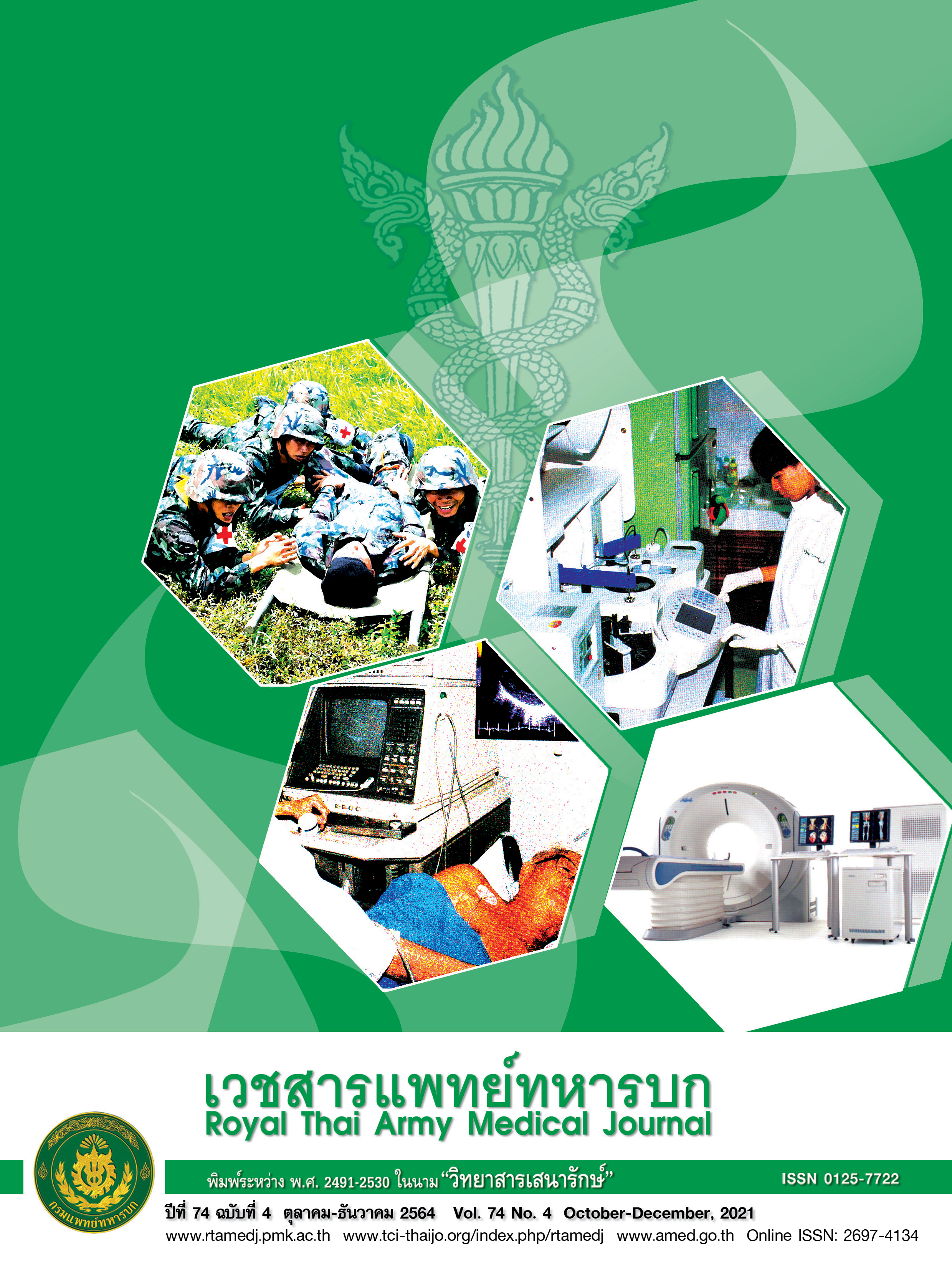Potassium Loss in Peritoneal Fluid and Peritoneal Equilibration Test in End Stage Renal Disease Patients
Main Article Content
Abstract
Background: Hypokalemia is a common problem in continuous ambulatory peritoneal dialysis (CAPD) patients. Potassium loss in peritoneal dialysate fluid is one of the main mechanisms for hypokalemia. The relationship between amount of potassium loss in peritoneal dialysate fluid and peritoneal membrane transporter has never been studied.
Objective: To evaluate the relationship between peritoneal potassium loss and peritoneal equilibration test (PET).
Methods: A cross-sectional study was conducted among CAPD patients treated at Phramongkutklao Hospital, Bangkok, Thailand, during April to August 2018. Patients were designed into four groups according to PET; high (H), high average (HA), low average (LA) and low (L). Kruskal Wallis test was used to determine the relationship between peritoneal potassium loss and type of peritoneal membrane according to PET.
Results: There were 54 CAPD patients during the study period, 34 patients were eligible for analysis. Of 34 eligible CAPD patients (H; 7, HA; 14, LA; 13, and L; 0), 15 (44.1%) patients had hypokalemia. H and HA groups experienced hypokalemia more frequently than LA group. Mean peritoneal potassium loss was 27.9+6.9 mEq/day. No difference was found between peritoneal potassium loss and types of peritoneal membrane; mean of peritoneal potassium loss were 25.6+5.6, 26.5+6.3, and 30.8+7.2 in H, HA, and LA groups, respectively (p=0.15). Fractional excretion of potassium (FE K) from peritoneal membrane were significantly higher in LA group (1.29+0.27%) and HA group (1.28+0.22%) than H group (1.04+0.11%), p=0.03.
Conclusion: Overall potassium loss in peritoneal fluid was 27.9±6.9 mEq/day. No difference was found between amount of potassium loss and type of peritoneal membrane, but trend to be higher in the average groups.
Downloads
Article Details
Articles in this journal are copyrighted by the Royal Thai Army Medical Department and published under the Creative Commons Attribution-NonCommercial-NoDerivatives 4.0 International (CC BY-NC-ND 4.0) license.
may be read and used for academic purposes, such as teaching, research, or citation, with proper credit given to the author and the journal.
Use or modification of the articles is prohibited without permission.
Statements expressed in the articles are solely the opinions of the authors.
Authors are fully responsible for the content and accuracy of their articles.
Any other republication of the articles requires permission from the journal.
References
2. Khan AN, Bernardini J. Johnston JR, et al. Hypokalemia in peritoneal dialysis patients. Perit Dial Int. 1996;16(6):652.
3. Kim S. Hyponatremia and hypokalemia in peritoneal dialysis patients. In: Krediet R. Progress in peritoneal dialysis: intechopen; 2011. p.145-53.
4. Burger CM. Emergency: hypokalemia. Am J Nurs. 2004;104(11):61-5.
5. Szeto CC, Chow KM, Kwan BC, Leung CB, Chung KY, Law MC, Li PK: Hypokalemia in Chinese peritoneal dialysis patients: prevalence and prognostic implication. Am K Kidney Dis. 2005;46:128-35.
6. Chuang YW, Shu KH, Yu TM, et al. Hypokalaemia: an independent risk factor of Enterobacteriaceae pertitonitis in CAPD patients. Nephrol Dial Transplant. 2009;24(5):1603-8.
7. Chittinandana A. Peitoneal dialysis prescription and adequacy monitoring: textbook of peritoneal dialysis.กรุงเทพมหานคร: เท็กซ์ แอนด์ เจอร์นัล พับลิเคชั่น; 2551. P 189-201.
8. Mehrotra R, Ravel V, and Kalantar-Zadeh K, et al. Peritoneal Equilibration Test and Patient Outcomes. Clin J Am Soc Nephrol. 2015 Nov 6;10(11):1990–2001.
9. Xu Q, Xu F, Fan L, et al. Serum potassium levels and its variability in incident peritoneal dialysis patients. PLoS One. 2014;9(1):e86750.
10. Amirmokri P, Morgan P, et al. Intra-peritoneal administration of potassium and magnesium. Ren fail. 2007;29(5):603.
11. Tziviskou E, Musso C,et al. Prevalence and pathogenensis of hypokalemia in patients on chronic peritoneal dialysis. Int Uro Nephrol. 2003;35(3):429.
12. Port F, Young E. Fluids and electrolytes disorders in dialysis. In Kokko J, Tannen R (Eds). Fluids and electrolytes. 1996 W. B.Saunders. Philadelphia : 542-44.


